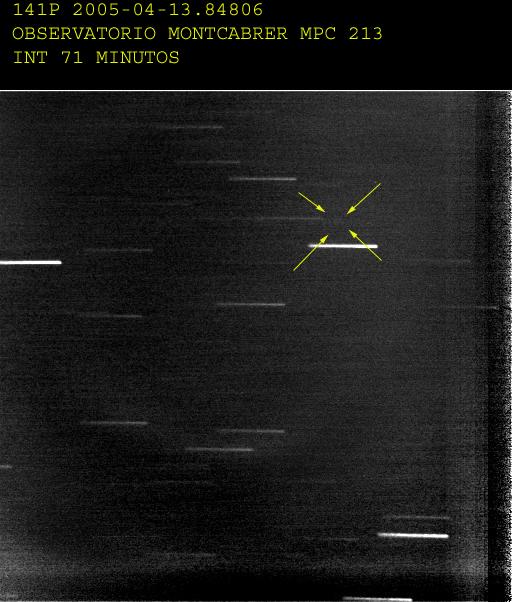141P/Machholz 2 = 1994 P1
Discovered
as a magnitude 10 object by Don Machholz on August 13th 1994 this is
an interesting and curious short-period object, with a period of just 5.23
years and perihelion just a fraction outside the orbit of Venus. Two weeks
after discovery a second, co-orbital component was found more than three
quarters of a degree behind the main comet and, in the first week of September,
three more faint components were found. From west to east these fragments were
designated A through to E. It was evident that the comet had suffered a major
fragmentation event at a previous return from perihelion and there was even a
suggestion that the fragmentation was ongoing as a double nucleus of D was
reported in October. The large size of the non-gravitational component of
motion suggests that unusual activity is still present.
Fragment
A was recovered on August 3rd 1999 and, later, D on October 17th.
Both brighten very rapidly as perihelion is approached with fragment A
passing from being between magnitude 20 and 21 at recovery, to magnitude 11 in
just 3 months.
Component
D faded out during December 1999 and just two observations were reported
after perihelion, both at the end of December. Although component A reached
magnitude 11.5 in 2005, D was not recovered and is presumed to have
disappeared.

This comet
is relatively challenging for CCD observers as it is only bright when at rather
small elongation. During the 2005 apparition we have just a single total visual
magnitude estimate by J.J. Gonzalez at m1=11.7 on March 11th
(T+12 days).
A 71 minute
integration on the comet (left) by Ramon Naves at MontCabrer (MPC 213) on April
13th failed to detect the comet.
Other
attempts to detect the comet by CCD observers in late April and early May 2005
failed to locate it to magnitude 18 (more than 3 magnitudes fainter than the
expected magnitude) so there is a possibility that the comet has faded out and
will not be recovered at its next return in 2010 when it is expected to reach
magnitude 12 in mid-June.
Detailed
information on the observational history of 141P/Machholz 2 can be found at
Gary Kronks wonderful site, here.
Seichii
Yoshida gives light curves for the 1999, 2005 and 2010 returns on his site, here.